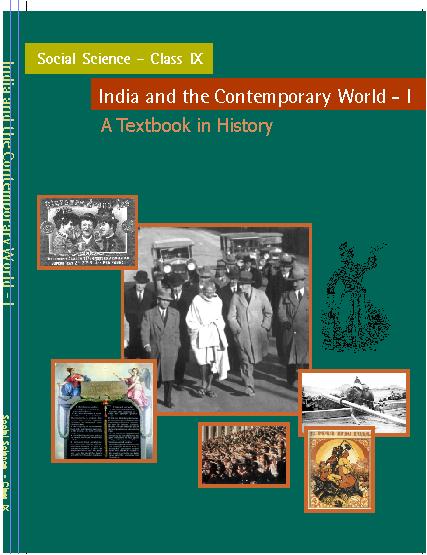Class 9 - Social Science India and the Contemporary World I
Chapter 5 - Pastoralists in the Modern World

Top Block 1
Question : 1 Explain why nomadic tribes need to move from one place to another. What are the advantages to the environment of this continuous movement?
Answer :
People who moved from one place to another, as a community, with all their belongings, were called nomads. These nomads moved from place to place in search of food and a livelihood. The nomadic pastoralists had herds of goats and sheep, or camels and cattle. Finding pasture for their herds was the main purpose of their constant movement.
The nomads moved between their summer and winter grazing grounds. In winter they usually lived on the low hills and the dry scrub forests provided pasture for their herds. They lived on the low hills during winter as the high mountains were snow covered. During summer, that is, by the end of April the nomads packed their belongings, round up their herds and start trekking towards the northern mountains. As the snow melted the mountains were converted into carpets of lush green grass. This provides ample pasture for their herds.The nomadic pastoralists thus moved annually between their summer and winter grazing grounds. When the pasture was exhausted or unusable in one place they moved their herds and flock to new areas.
The continuous movement of the nomads with their grazing herds ensured that the natural pastures were not over used. The movement allowed the grass and foliage to grow again and this preserved the environment.
Question : 2 Discuss why the colonial government in India brought in the following laws. In each case, explain how the law changed the lives of pastoralists:
Answer :
♦ Waste Land Rules
Uncultivated land was taken over by the colonial government and given to selected individuals. This rule was called Waste Land rules. It was brought into force during the mid-nineteenth century.
Some of the individuals, who were given this land, by the government, were made headmen. This assured the colonial government their loyalty and support.
The waste lands that were taken over, were actually grazing tracts, used by the nomadic pastoralists. When this waste land was brought under cultivation by the new owners, the pastoralists lost their grazing grounds and were put to a lot of hardship.
♦ Forest Acts
The colonial government passed the Indian Forest Acts in 1865. This Act was amended in the year 1878. Under this amendment the forests were divided into 3 categories, – reserved, protected and village forests.
The reserved forests were usually forests which produced commercially valuable timber. The Forest Act ensured that the total wealth of these forests could be enjoyed by the colonists alone, as no one was allowed access to these forests.
Under this Act nomads were not allowed to graze their cattle in these forests. They had to get permit to graze their cattle in a few of these forests. If they overstayed their permit period they were fined or punished. This left the nomads with no pasture for their herds.
♦ Criminal Tribes Act
The colonial government in India passed the Criminal Tribes Act in the year 1871. The Act earmarked communities of craftsmen, traders and pastoralists as Criminal Tribes. These communities were forced to live only in notified village settlements, when this Act came into force. They needed a permit to move out of this specified village. The village police also kept a continuous watch over them.
The moving nomads disturbed the Colonist . They wanted the natives in fixed places with fixed rights so that they could be easily controlled.
The Criminal Tribes Act was a great insult to the honest hardworking nomads. Their entire way of life was affected .
♦ Grazing Tax
Pastoralists had to pay taxes for the animals they grazed on the pastures. This was called the Grazing Tax.
The colonial government wanted to increase its revenue. Tax was imposed on land, on canal water, on salt, on trade goods, on animals and even on grazing. In the mid- nineteenth century, grazing tax was introduced in most pastoral tracts of India.
The pastoralists had to show a pass and pay tax to enter a grazing tract. He had to pay tax according to the number of cattle heads he had .This taxation was a terrible burden on the poor pastoralists.
Question : 3 Give reasons to explain why the Maasai community lost their grazing lands.
Answer :
The Maasais were a community of cattle herders. They lived primarily in East Africa. There were 300, 000 Maasais in Southern Kenya and 150,000 in Tanzania. The Maasais occupied a vast stretch of land from North Kenya to the steppes of Northern Tanzania. The lush green grass of the steppes provided ample fodder for their herds.
In the nineteenth century, European imperial powers captured Africa and scrambled for territorial possessions. They drew up boundaries and took over the land that was hitherto occupied by the Maasais. The Maasai lost about 60 per cent of their pre-colonial lands. They were restricted to a dry zone with uncertain rainfall and poor pastures. The Maasais faced continuous loss of their grazing lands and this affected their lives in times of drought and even reshaped their social relationships.The British colonial government in East Africa encouraged the local peasant communities to expand cultivation. Soon pasturelands were turned into cultivated fields and the Maasai community yet again lost its grazing fields.
The colonist also converted grazing land into Game Reserves. The pastoralists were not allowed to enter these reserves. Thus the grazing grounds of the Maasais was once again confiscated. The Maasais were soon restricted to small areas. They could not hunt or graze their animals in the reserved areas. Due to the restriction to small areas, fodder became scarce. Large numbers of Maasai cattle died of starvation and disease.
The loss of the finest grazing lands and water resources created a lot of hardship for the Maasis.
Formulae Handbook for Class 9 Maths and ScienceEducational Loans in India
Question : 4 There are many similarities in the way in which the modern world forced changes in the lives of pastoral communities in India and East Africa. Write about any two examples of changes which were similar for Indian pastoralists and the Maasai herders.
Answer :
The problems faced by the Indian pastoralist due to the enforcement of the Wasteland Rules was similar to the problem faced by the Maasai community in Africa. The British Colonial government in East Africa encouraged the local peasant communities to expand cultivation. Pasturelands were turned into cultivated fields and the Maasai community lost its grazing fields. Similarly, under the Wasteland Rules, pastoral land was taken from the pastoralists and given to local individual who in turn brought the land under cultivation. The Maasais and the Indian pastoralists lost their grazing grounds.
Yet another problem faced by the Maasais and the Indian pastoralists was the restriction that was imposed on them by the colonist . The Indian Forest Acts, restricted the Indian pastoralist from entering the reserved forests which were rich in pasture. Similarly the colonist in East Africa converted grazing land into Game Reserves. The pastoralists were not allowed to enter these Reserves.
The pastoral communities in India and East Africa had to endure many hardships as the demands of the modern world grew increasingly.
Additional Questions
Question : 1 Where do the Pastoralists normally live?
Answer :
The Pastorals normally live in the mountainous areas. These mountain areas are e generally covered with lots of shrub forests. These shrubs provide food for their cattle and sheep.
Question : 2 Name the pastoralists in India and mention where they lived?
Answer :
There were seven major pastoralist communities in India. They were :-
1. The Bakarwals of Jammu and Kashmir
2. The Gaddi shepherds of Himachal Pradesh
3. The Gujjar cattle herders of Garhwal and Kumaon
4. Dhangars of Maharashtra.
5. The Gollas, Kurumas and Kurubas of Karnataka and Andhra Pradesh.
6. The Banjaras of Uttar Pradesh, Punjab, Rajasthan, Madhya Pradesh & Maharashtra
7. The Raika of the Rajasthan desserts.
Question : 3 Trace the movement of the Bakarwals of Jammu and Kashmir.
Answer :
The Bakarwals of Jammu and Kashmir reared goats and sheep. They lived with their herds on the low hills of the Siwalik range.
In winter, when the mountains were covered with snow they moved on to the valleys of Kashmir. Several families moved together in a Kafila. The crossed the PirPanjal passes of the mountains and entered the valley.
In summer when the snow melts, the Bakarwals return to the mountains which are now covered with lush green grasslands.
Question : 4 Name the two groups in the Raikas of the Rajasthan deserts.
Answer :
The Raikas of the Rajasthan desserts can be classified into two groups according to the animals they reared. The MarusRaikas reared camels while the Raikas reared sheep and goats.
Question : 5 What were the activities that the Raikas were involved in?
Answer :
The Raikas combined a range of different activities – cultivation, trade and herding – to make their living .
During the monsoons, the Raikas of Barmer, Jaisalmer, Jodhpur and Bikaner stayed in their villages and cultivated crops. They traded with the local farmers to get their requirement. They also had to maintain good relations with the local farmers so that the farmers would let their cattle graze in harvested fields.
The Raikas had to be good in predicting the weather so that they would be able to move about safely. They had to be experts in sporting natural resources water and pasture.
Question : 6 Write a note on the Dhangars of Maharashtra.
Answer :
Dhangars were an important pastoral community in Maharashtra. In the early twentieth century their population was estimated to be 467,000. The Dhangras were mainly shepherds. Some of them were blanket weavers, while a few reared buffaloes.
The Dhangars stayed in the central plateau of Maharashtra during the monsoons. The central plateau had very low rain fall and was very dry. It was covered with only thorny shrubs. As the soil was poor only dry crops like bajra could be grown there.
During monsoon the picture was entirely different. The area became a vast grazing ground for the Dhangar flocks. The Dhangars harvested their bajra by October every year and then moved westward.
The Dhangars reached Konkan in the month of March, annually. Konkan was a flourishing agricultural land with high rainfall and rich soil. The pastoralists were welcomed by Konkani peasants. The Konkani peasants also gave supplies of rice to the Dhangars , who took it back to the plateaus, where grain was scarce.
As the monsoons set, the Dhangars left the Konkan and the coastal areas with their flocks and returned to their settlements on the dry plateau as their sheep could not tolerate the wet monsoon conditions.
Constant movement was the way of life of the pastoralists.
Question : 7 What are Gujjar Mandaps?
Answer :
The huts in which the Gujjar cattle herders, of Ghahwal stay, are called Gujjar Mandaps. These huts are made up of bamboo and grass. They are situated at about 10,000 to 11,000 feet, as buffaloes cannot climb any higher. The mandap is also a work place for the herders. They make ghee in these huts.
Question : 8 Mention the Acts that were enforced by the colonial government that affected the lives of the pastoralist community.
Answer :
The colonial government enforced four major laws that affected the pastoralists in a devastating manner. They were:-
♦ Waste Land rules
♦ Forest Acts
♦ Criminal Tribes Act
♦ Grazing Tax.
Mddle block 1
Question : 9 How did the laws enforced by the colonial government affect the lived of the pastoralists?
Answer :
The laws brought a lot of hardship to the pastoralists. The laws led to a serious shortage of pastures, which was very important for the nomads. Under the new laws grazing lands were taken over and turned into cultivating fields and thus the available area of pastureland declined.
The reservation of forests meant that shepherds and cattle herders could no longer freely graze their cattle in the forests.
The restrictions and reservations the laws enforced threatened the very livelihood of the pastoralists and many had to resettle and adapt themselves to the new ways of the world.
Question : 10 How did the pastoralists cope with the changes brought about by the new laws?
Answer :
Pastoralists reacted to these changes in a variety of ways. Some reduced the number of cattle in their herds, since there was not enough pasture to feed large numbers. Others discovered new pastures, when old grazing grounds were banned by the government.
Over the years, some rich pastoralists began buying land and settling down, giving up their nomadic life they settled down to cultivating land. Others took to extensive trading.
Poor pastoralists, borrowed money from moneylenders to survive, at times they lost their cattle and sheep and became labourers, working on fields or in small towns.
The changes that took place in India, was also seen in other parts of the world. New laws and settlement patterns forced pastoral communities to alter their lives.
Question : 11 Mention a few Pastoral communities in Africa.
Answer :
There are over 22 million Africans depending on some form of pastoral activity or other for their livelihood, till today.
Some of the Pastoral communities in Africa are :-
♦ Bedouins
♦ Berbers
♦ Maasai
♦ Somali
♦ Boran
♦ Turkana
Most of them now live in the semi-dry grasslands or deserts where rain fed agriculture is difficult.
Question : 12 What were the social changes that occurred in the Maasai pastoral community?
Answer :
The social changes in the Maasai society occurred at two levels.
Firstly, the traditional difference based on age, between the elders and warriors, was disturbed, though it did not break down entirely. Secondly, a new distinction between the wealthy and poor pastoralists developed.
The pastoral communities in different parts of the world were affected in a variety of ways, by the changes in the modern world. New laws and new borders affected the patterns of their movement and their livelihood.
Question : 13 How did the pastoralists in Africa adapt themselves to tide over the bad times?
Answer :
The life of poor pastoralists, in Africa, who depended mainly on their livestock, became very difficult in times of war and famine. during these times they lost every thing.
To tide over the bad times the pastoralists had to go looking for work in towns. Some found a living as charcoal burners and others did odd jobs. A few of the pastoralists were lucky to get more regular work in road or building construction.
Question : 14 How did the British administer the affairs of the Maasai community?
Answer :
The British appointed chiefs of different sub-groups of the Maasai community to administer their affairs. They were made responsible for the affairs of the tribe. The chiefs appointed by the colonial government accumulated wealth over the years. They had a regular income with which they could buy animals, goods and land. Many of them began living in towns, and became involved in trade.
Question : 15 What were the views of Environmentalists and economists on pastoral nomadism?
Answer :
Environmentalists and economists felt that pastoral nomadism was the way of life that was best suited to many hilly and dry regions of the world.



